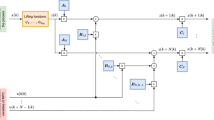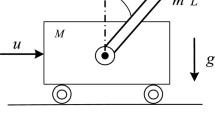Abstract
Four-bar linkage mechanisms have dragged the attention of many specialists due to its importance in the academic and industrial sectors. Hence, a lot of research work has been conducted to understand their complex behavior and explore various control techniques. In fact, such mechanisms possess highly nonlinear dynamics that require advanced nonlinear control methods. In addition, the four-bar linkage mechanism is exposed to significant dynamic fluctuations at high speeds due to the system inertias. In this paper, a backstepping control algorithm with a robust scheme is designed and applied on the four-bar linkage mechanism to investigate and explore its dynamical performance under various operating conditions and without a priori knowledge of the model parameters. Five operating conditions are introduced and tested in numerical simulations to show that the proposed nonlinear controller successfully regulates and tracks the speed of the driving link of the mechanism and shows a satisfactory performance.
Similar content being viewed by others
Abbreviations
- B :
-
vicious damping at motor bearing
- C :
-
torsional damping coefficient
- c m i :
-
center of mass of the ith link
- i a :
-
motor armature current
- J :
-
moment of inertia of the motor rotor and gear
- J i :
-
moment of inertia of the ith link
- K :
-
torsional spring constant
- k b :
-
motor electromotive force voltage constant
- k e :
-
positive control gain
- k m :
-
motor torque constant
- k o :
-
positive control gain
- k η :
-
positive control gain
- L a :
-
motor armature inductance
- L i :
-
length of inertia of the ith link
- m i :
-
mass of inertia of the ith link
- n :
-
gear ratio
- R a :
-
motor rotor armature resistor
- r i :
-
location of the center of mass of the ith link
- T :
-
total applied torque on the leading link (i.e., link 2)
- T L :
-
mechanical load torque
- T m :
-
motor output torque
- V a :
-
applied armature voltage
- ε 1 :
-
arbitrary small positive constant
- ε 2 :
-
arbitrary small positive constant
- ε i :
-
arbitrary small positive constant
- ε x :
-
arbitrary small positive constant
- λ 1 :
-
positive constant
- λ 2 :
-
positive constant
- λ 3 :
-
positive constant
- σ :
-
small positive constant
- \(\ddot {{\phi }}_{i}\) :
-
angular acceleration of the ith link
- \(\dot {{\phi }}_{i}\) :
-
angular velocity of the ith link
- ϕ i :
-
angular displacement of the ith link
References
Al-Jarrah, A., Salah, M., Banihani, S., Al-Widyan, K., Ahmad, A.: Applications of various control schemes on a Four–Bar linkage mechanism driven by a geared DC motor. WSEAS Trans. Syst. Control 10, 584–597 (2015)
Boscariol, P., Gasparetto, A., Zanotto, V.: Model predictive control of a flexible links mechanism. J. Intell. Robot. Syst. 58(2), 125–147 (2010)
Bulatovic, R., Dordevic, S.: On the optimum synthesis of a four-bar linkage using differential evolution and method of variable controlled deviations. Mech. Mach. Theory 44(1), 235–246 (2009)
Choudhary, V.B., Singh, V.K., Dutta, A.: Design of an optimal 4-bar mechanism based gravity balanced leg orthosis. J. Intell. Robot. Syst. 86(3-4), 485–494 (2017)
Diken, H.: Trajectory control of mass balanced manipulator. Mech. Mach. Theory 32(3), 313–322 (1997)
Ebrahimi, S., Payvandy, P.: Efficient constrained synthesis of path generating four bar mechanisms based on the heuristic optimization algorithms. Mech. Mach. Theory 85, 189–204 (2015)
Erentürk, K.: Hybrid control of a mechatronic system: fuzzy logic and grey system modeling approach. IEEE/ASME Trans. Mechatronics 12(6), 703–710 (2007)
Ge, Z., Li, X., Ren, Z., Yang, F.: Research on the Hybrid Cam-Linkage Mechanism Realizing Trajectory. In: International Technology and Innovation Conference (ITIC), Hangzhou, China, pp 2012–2016 (2006)
Gündoğdu, Ö., Erentürk, K.: Fuzzy control of a dc motor driven four-bar mechanism. Mechatronics 15(4), 423–438 (2005)
Hassan, A., Abomoharam, M.: Design of a Single DOF Gripper Based on Four-Bar and Slider-Crank Mechanism for Educational Purposes. In: 24th CIRP Design Conference, Procedia CIRP, vol. 21, pp 379–384 (2014)
Huang, T.-H., Huang, H.-P., Kuan, J.-Y.: Mechanism and control of Continuous-State coupled elastic actuation. J. Intell. Robot. Syst. 74(3-4), 571–587 (2014)
Khalil, H.: Nonlinear Systems. 3rd Ed. Prentice Hall (2002)
Krstic, M., Kanellakopoulos, I., Kokotovic, P.: Nonlinear and Adaptive Control Design. Wiley, New York (1995)
Liaw, H.-C., Shirinzadeh, B.: Enhanced adaptive motion tracking control of piezoactuated flexure-based four-bar mechanisms for micro/nano manipulation. Sensors Actuators A Phys. 147(1), 254–262 (2008)
Lin, M.-C., Chen, J.-S.: Experiments toward MRAC design for linkage system. Mechatronics 6(8), 933–953 (1996)
Liu, Y.-H.: Saturated robust adaptive control for uncertain non-linear systems using a new approximate model. IET Control Theory Appl. 11(6), 870–876 (2017)
Lungu, R., Sepcu, L., Lungu, M.: Four-bar mechanism’s proportional-derivative and neural adaptive control for the thorax of the micromechanical flying insects. ASME J Dyn. Syst., Measurement, and Control 137(5), 051005–0510017 (2015)
Maeda, Y., De Figueiredo, R.J.B.: Learning rules for neuro-controller via simultaneous perturbation. IEEE Trans. Neural Netw. 8(5), 1119–1130 (1997)
Marquez, H.: Nonlinear Control Systems – Analysis and Design. Wiley, New York (2003)
Nariman-Zadeh, N., Felezi, M., Jamali, A., Ganji, M.: Pareto optimal synthesis of four-bar mechanisms for path generation. Mech. Mach. Theory 44(1), 180–191 (2009)
Qu, Z.: Robust Control of Nonlinear Uncertain Systems. Wiley, New York (1998)
Rajesh Kanna, G., Ashik, M.: Design and development of a rope climbing robot using four bar mechanism with wireless control using TX2/RX2 RF Module. In: IEEE International Conference on Signal Processing, Informatics, Communication and Energy Systems (SPICES), Kozhikode, India, pp 1–6 (2015)
Ren, Q., Bigras, P.: A highly accurate model-free motion control system with a Mamdani fuzzy feedback controller Combined with a TSK fuzzy feed-forward controller. J. Intell. Robot. Syst. 86(3–4), 367–379 (2017)
Sánchez-Márquez, Á., Vega-Alvarado, E., Alfredo Portilla-Flores, E., Mezura-Montes, E.: Synthesis of a Planar Four-Bar Mechanism for Position Control Using the Harmony Search Algorithm. In: 11Th International Conference on Electrical Engineering, Computing Science, and Automatic Control (CCE), Campeche, Mexico, pp 1–6 (2014)
Ting, C.-S., Chang, Y.-N., Shi, B.-W., Lieu, J.-F.: Adaptive backstepping control for permanent magnet linear synchronous motor servo drive. IET Electr. Power Appl. 9(3), 265–279 (2015)
Yan, H.-S., Yan, G.-J.: Integrated control and mechanism design for the variable input-speed servo four-bar linkages. Mehcatronics 19(2), 274–285 (2009)
Youcef-Toumi, K.: Analysis, Design and Control of Direct Drive Manipulators PhD Dissertation. Mechanical Engineering Department, Massachusetts Institute of Technology (1985)
Youcef-Toumi, K., Kuo, A.: High-speed trajectory control of a direct-drive manipulator. IEEE Trans. Robot. Autom. 9(1), 102–108 (1993)
Zhang, W., Chen, X.: Mechatronics design for a programmable closed-loop mechanism. Proc. IME C J Mech. Eng. Sci. 215(3), 365–375 (2001)
Zhang, K.: Research on high precision control system of a hybrid five-bar actuator. In: International Technology and Innovation Conference (ITIC), Hangzhou, China, pp 2149–2154 (2006)
Zhang, W.J., Li, Q., Guo, L.S.: Integrated design of mechanical structure and control algorithm for a programmable four-bar linkage. IEEE/ASME Trans. Mechatron. 4(4), 354–362 (1999)
Zhang, Z., Park, J.H., Shao, H., Qi, Z.: Exact tracking control of uncertain non-linear systems with additive disturbance. IET Control Theory Appl. 9(5), 736–744 (2015)
Zhao, H.: Application of robust adaptive backstepping control in a class of uncertain nonlinear system. In: International Conference on Automatic Control and Artificial Intelligence (ACAI), Xiamen, China, pp 558–560 (2012)
Acknowledgments
Work of E. Tatlicioglu is partially supported by The Scientific and Technological Research Council of Turkey via grant number 116M272.
Author information
Authors and Affiliations
Corresponding author
Additional information
Publisher’s Note
Springer Nature remains neutral with regard to jurisdictional claims in published maps and institutional affiliations.
Rights and permissions
About this article
Cite this article
Salah, M., Al-Jarrah, A., Tatlicioglu, E. et al. Robust Backstepping Control for a Four-Bar Linkage Mechanism Driven by a DC Motor. J Intell Robot Syst 94, 327–338 (2019). https://doi.org/10.1007/s10846-018-0811-y
Received:
Accepted:
Published:
Issue Date:
DOI: https://doi.org/10.1007/s10846-018-0811-y




